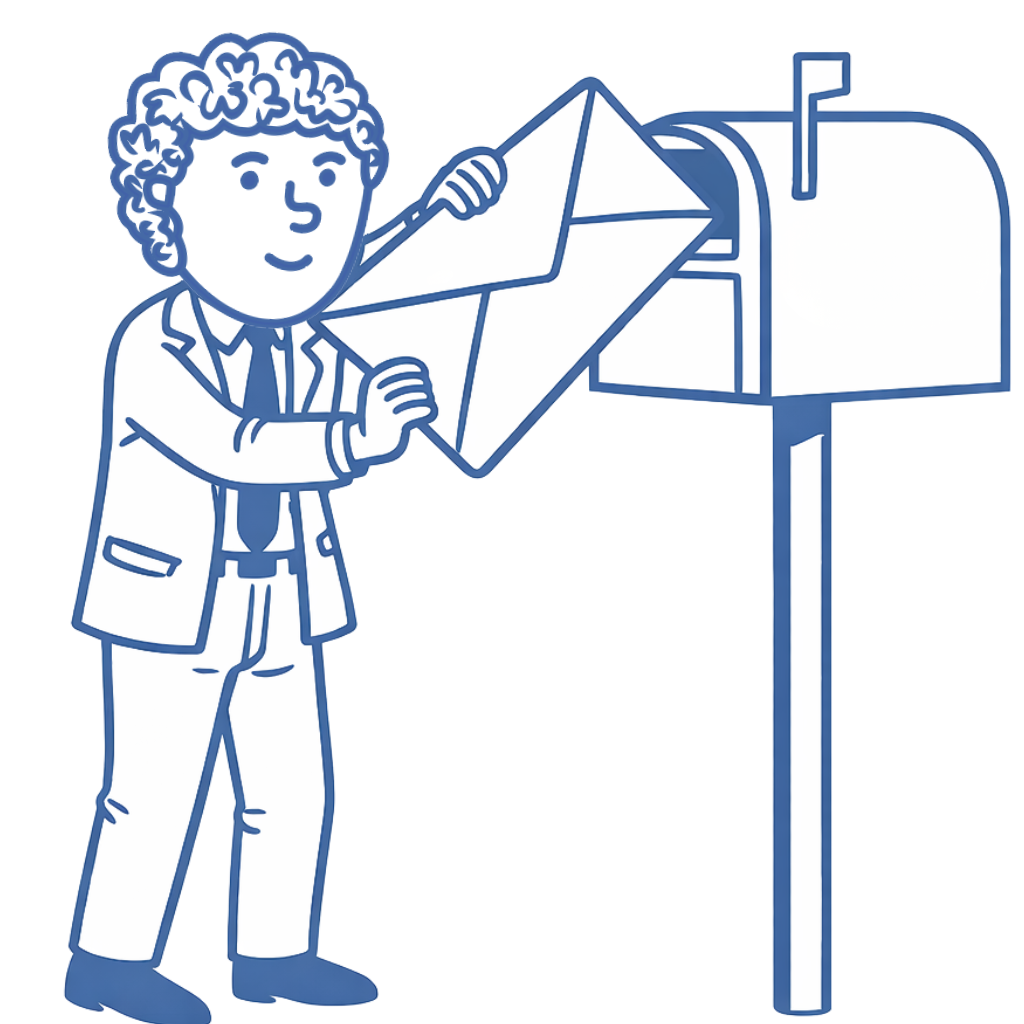Table of Contents
- Most replies come fast: 57% of link-building replies and 69.4% of digital PR replies happen within 6 hours.
- Average response times are 12.85 hours for link builders, 11.4 hours for digital PRs.
- Education, Fashion & Beauty had the fastest link building reply times.
- Fashion & Beauty, Home & Lifestyle were the quickest for digital PR.
- Travel-related pitches are the slowest to get replies for link building and digital PR.
- Most digital PR emails don’t get replies at all.
Getting links or press mentions doesn’t happen overnight.
Crafting a persuasive pitch, building a targeted list, and sending emails at just the right time to ensure they see and open them is a process.
But the most challenging part is the waiting.
Some responses take hours, others days. Most never come, even when the outcome is positive.
The waiting causes you to second-guess your pitch, ideas, and email list.
Maybe even tempting you to send some excessive follow-ups.
To comfort you, we looked into our database of emails sent to understand how long it takes link builders and digital PRs to get responses from email outreach.
Before we start, since “link building” is universal, I’m including all customers who use BuzzStream for tactics like guest posts, digital PR, broken link building, and resource page email outreach.
This included over 51 million emails.
You can see the full methodology parameters here.
How Long Does it Take Link Builders to Get Email Replies?
For link builders, 57% of replies arrive within 6 hours, and almost 90% arrive within 2 days.
Let’s take a look at the breakdown:
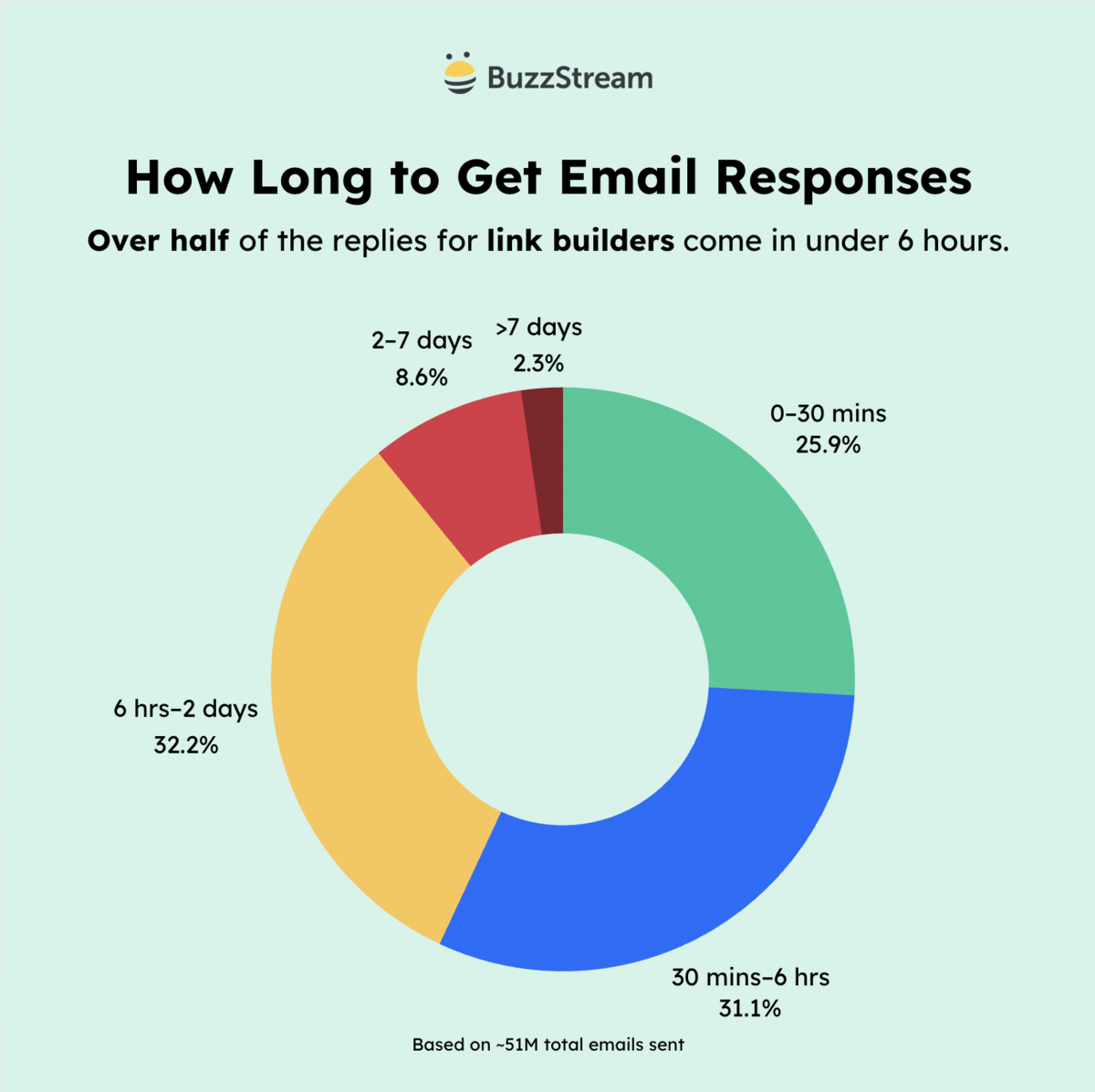
Overall, the average time it takes to respond is 12.85 hours (due to the long tail of responses).
My main takeaway is that your pitches will get quick responses if people are interested.
The other is that you should wait 48 hours before your first follow-up.
Next, look into the industry breakdown:
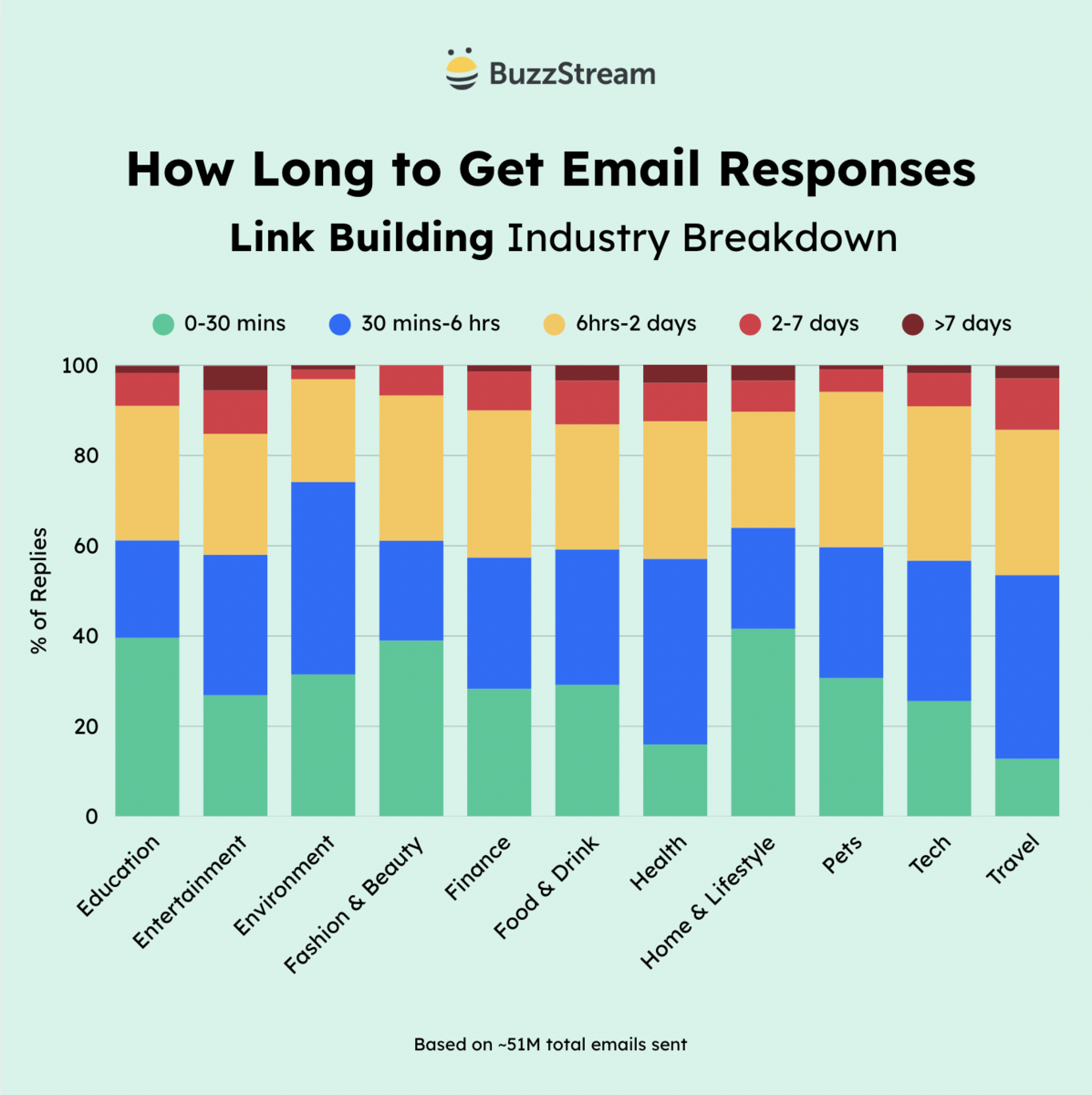
As you can see, response times vary in specific industries.
Some industries, like Education, Fashion and Beauty, and Home and Lifestyle, have the quickest response times for link building.
This reflects my experience. I’ve always had an easier time getting links related to Education campaigns because many universities and libraries have fairly active webmasters.
There is also an overabundance of fashion and lifestyle bloggers, so when an opportunity arises, they seem quicker to seize it.
Others, like Travel, Tech, or Health, come in over days, not hours. Travel is the slowest overall, perhaps because it is a heavily monetized industry with a lot of affiliate content, so link building gets slightly deprioritized.
However, guest posting or resource page building for website editors differs greatly from digital PR outreach to journalists.
So, next, let’s dig into the response times for digital PR email outreach.
How Long Does it Take Digital PRs to Get Replies?
For digital PRs, 69.4% of responses come before the 6-hour mark, and the vast majority (88.6%) come under 2 days.
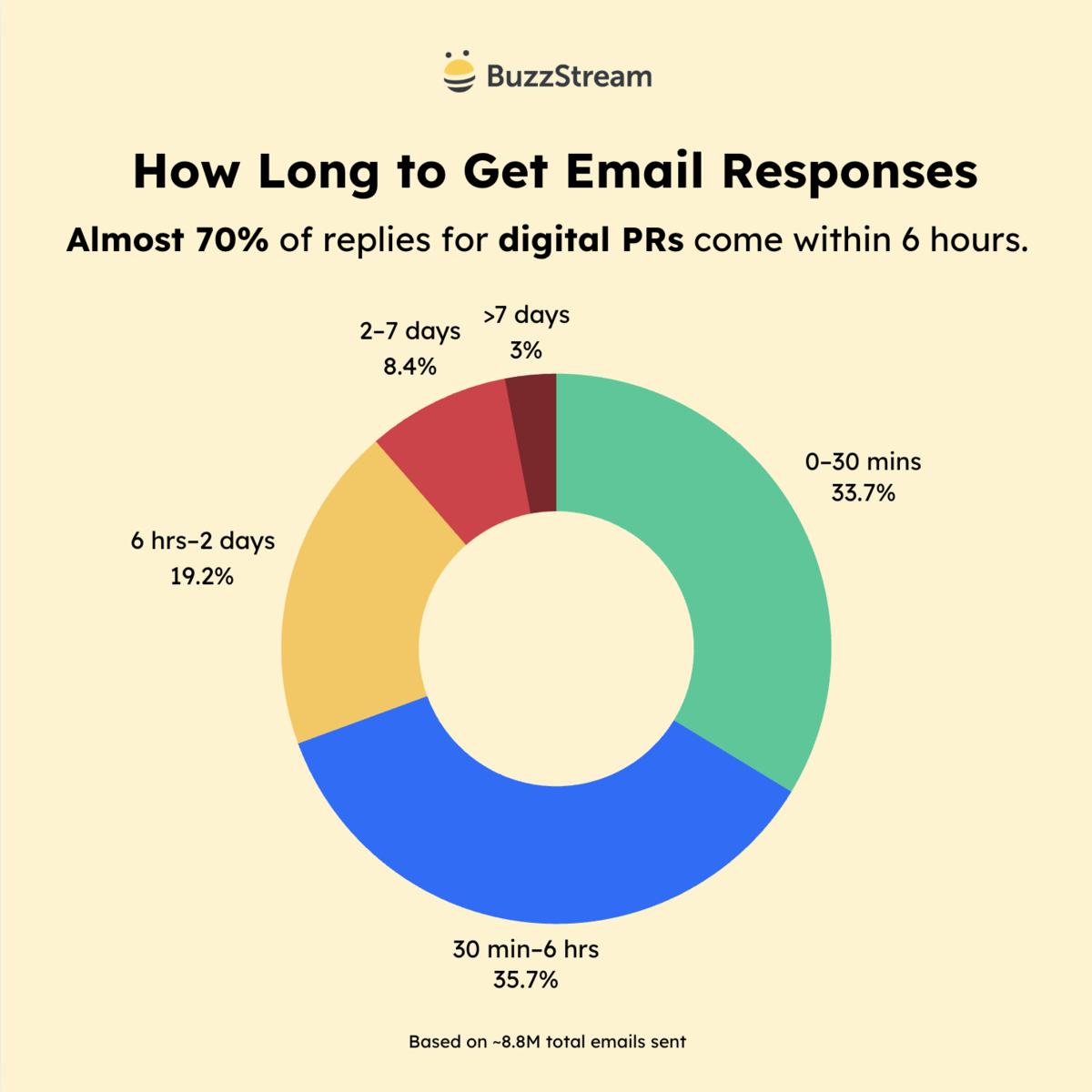
The average response for digital PRs is 11.4 hours, slightly lower than the link builders’ response time.
Like link building outreach, most journalist replies come within the first 12 hours, suggesting that interest is often immediate, and anything later is likely a pass.
Let’s look at the industry breakdown next.
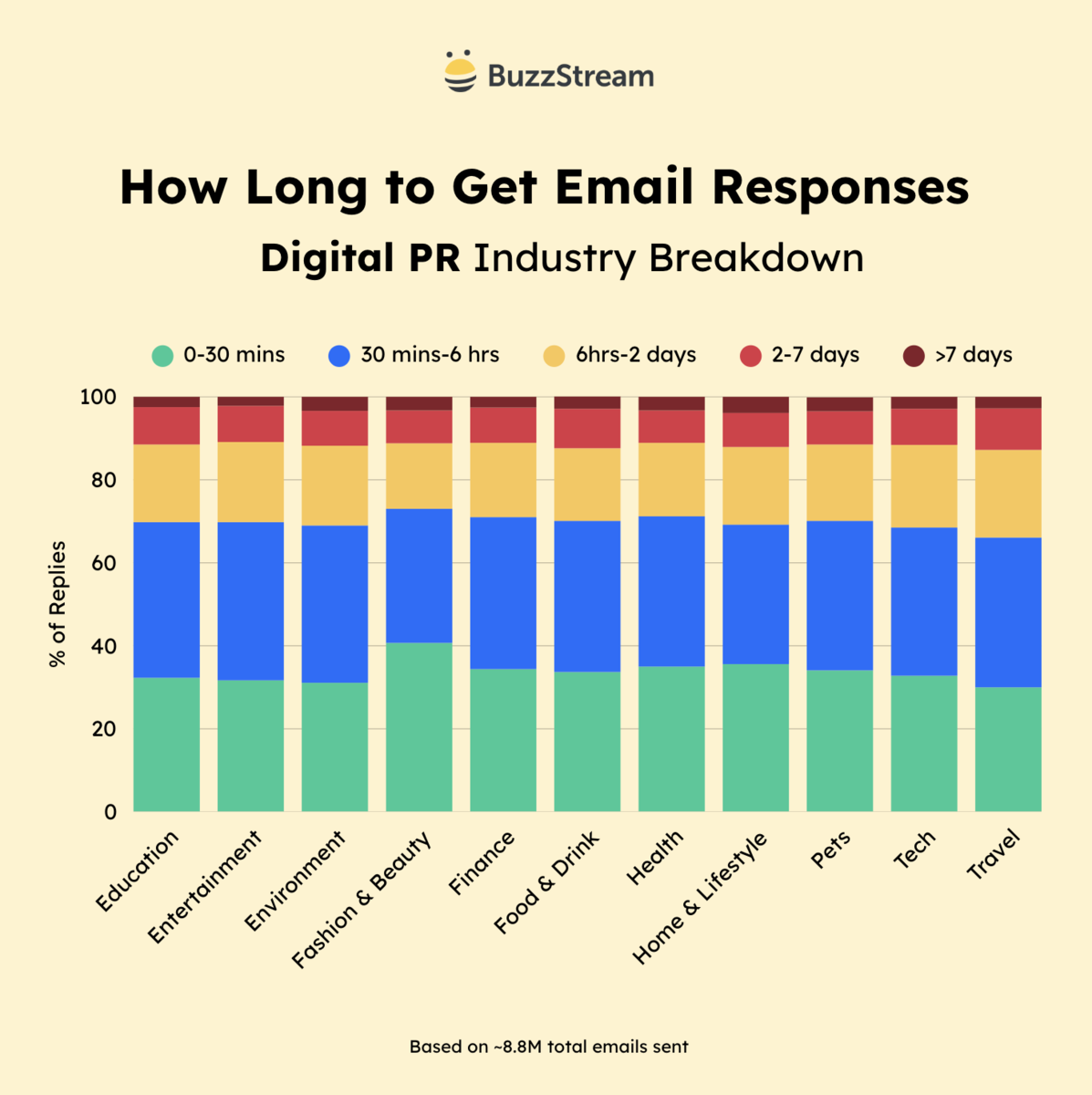
The Fashion and Beauty industry has the fastest reply times in our dataset. Other top responders are Home and lifestyle, and Finance.
Fashion, Lifestyle, and Finance are all quick-moving industries, so unsurprisingly, they’re at the top.
Travel is the slowest of the early responders, which may make sense given that travel PR takes a lot more seasonality into account and thus requires more campaign planning.
With this in mind, you might think these are the most successful or active industries.
This isn’t the case.
Let me show you why.
Quick Response Rate Doesn’t Always Mean Success
There are two quick things to remember with this study.
Not all responses are positive. These are just response times. They could just as quickly respond by saying no.
So, don’t let this fool you into thinking you are doomed if you haven’t heard back in 2 days. (It does mean you should spread out your follow-ups, though.)
Not everyone responds, even if they take action on your request.
Muck Rack’s State of Journalism report showed that journalists respond to pitches about half the time, whether good or bad.
I’d trust journalists’ response rates and response times even less to indicate success.
That said, there are ways to increase the likelihood of your email getting a response.
How to Increase the Likelihood That Your Email Gets a Response?
In the link-building game, responses are a slightly better indicator of success than digital PR.
I will skip obvious tips like getting their email address correct or writing a good email, because those are the foundations of every campaign.
Here are some actionable, data-backed tips for better responses.
1. Send Fewer, More Targeted Emails
We’ve seen that campaigns with fewer than 100 emails had significantly higher reply rates than those with thousands.
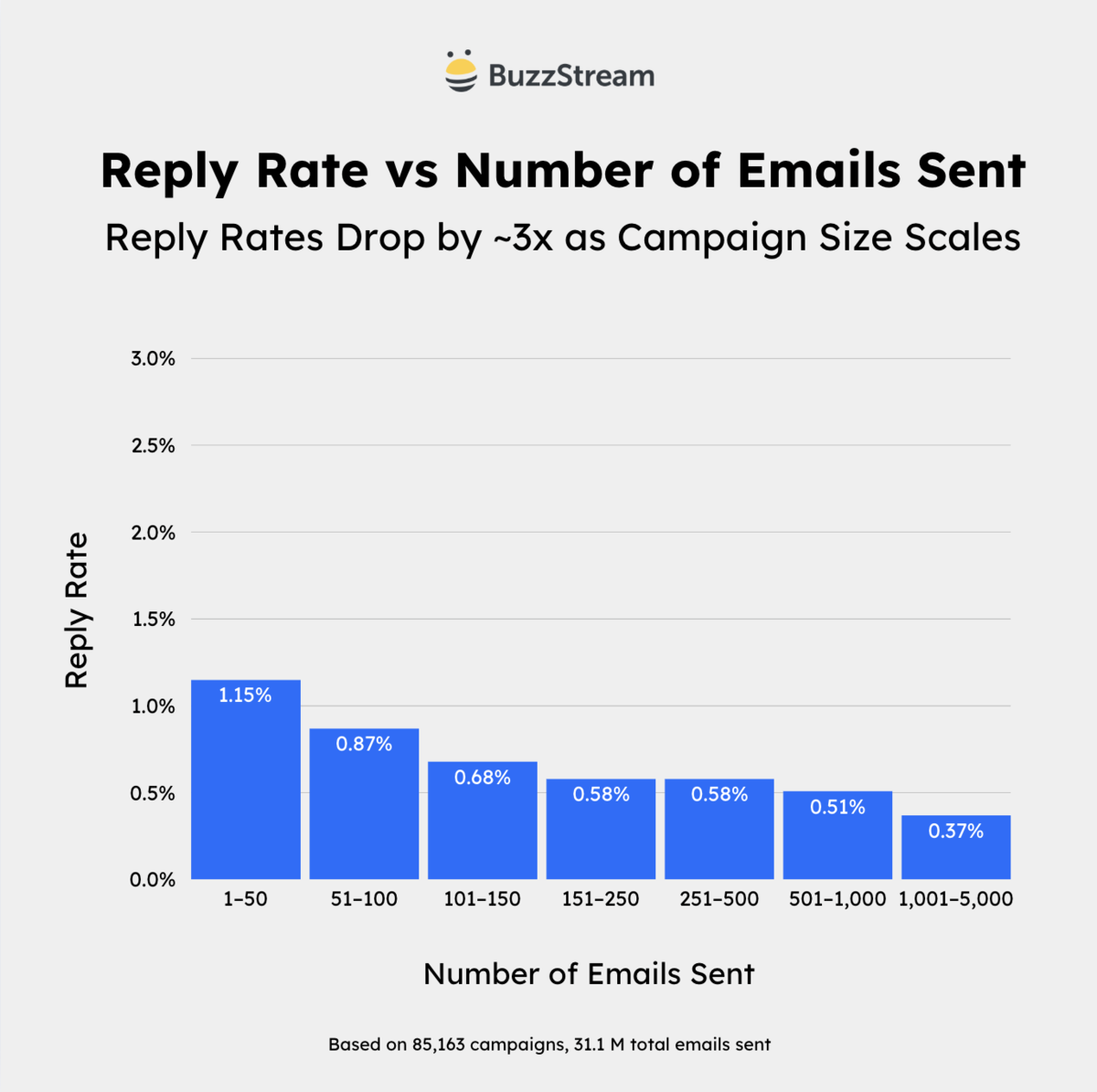
Link builders and PRs who take the time to ensure their emails are personalized and highly targeted have better success.
Before sending, give them a F.I.T. check:
- Freshness – are they still active at the pub or website?
- Industry Alignment – do they still cover the space you’re in?
- Topical Relevance – is your pitch relevant to what they’ve written about?
Our new ListIQ tool helps build relevant lists quickly.
Collin Czarnecki, owner of digital PR agency Noble (and a former journalist) adds timing to this mix:
“Overall, the topic of your pitch and the vertical you’re targeting play a huge role in whether you get a response.
That’s why timing and relevance are everything.
If you pitch into a trending or breaking news cycle and your content adds value, you’re more likely to hear back.
TV reporters, particularly producers, tend to respond more often because they’re working against tighter deadlines.
If they reach out with a question and you can’t respond quickly, you’ve likely missed your shot.
That’s why it’s critical to monitor your inbox closely after pitching, organize and prepare your data, and ensure your spokesperson is available for follow-ups or comments that day or before the reporter’s deadline.
Again, if you miss their deadline, you’ll most likely miss your shot at a placement.
2. Provide Value
The biggest mistake most people make is asking for something and giving nothing in return.
Value can mean different things, but in most cases, it’s either sharing valuable information or doing the legwork so that others don’t have to.
For link builders, providing value might mean asking for a link insertion and showing the recipient where exactly you want it inserted.
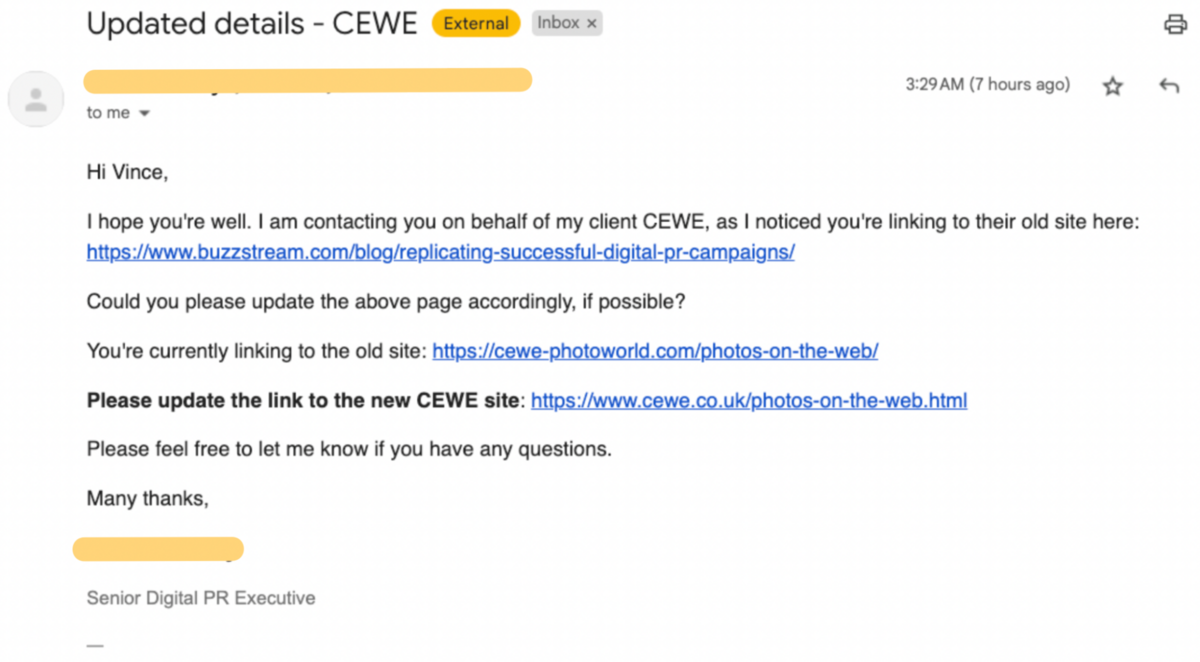
For journalists, value means quickly providing all the relevant information they need to write a great story.
Read more about what makes a great media pitch.
3. Don’t Fake Personalization
I’ve received too many emails with corny personalization to count.
There’s the obvious personalization, where they just tell you that they liked your article, like this one, which said they found out about my highly educational article:

And some might think they can use AI to scale this. Unfortunately, it’s just not there yet.
I’ve seen people try using things like location data through LinkedIn, but you end up with messages like this, where they mention the weather in my hometown, thinking that is the key to “personalization.”

For me, these are easy emails to ignore or mark as spam.
4. Double Touch Technique
One example I always give is the double-touch technique. Essentially, you first reach out to someone on a platform other than email, like social media, and then follow up with an email.
For example, I tagged Positional early last year in a LinkedIn post about internal linking. Nate saw that and responded on LinkedIn.
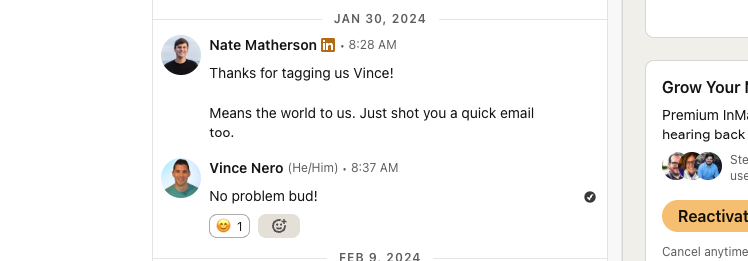
Then, he followed up with an email with a request.
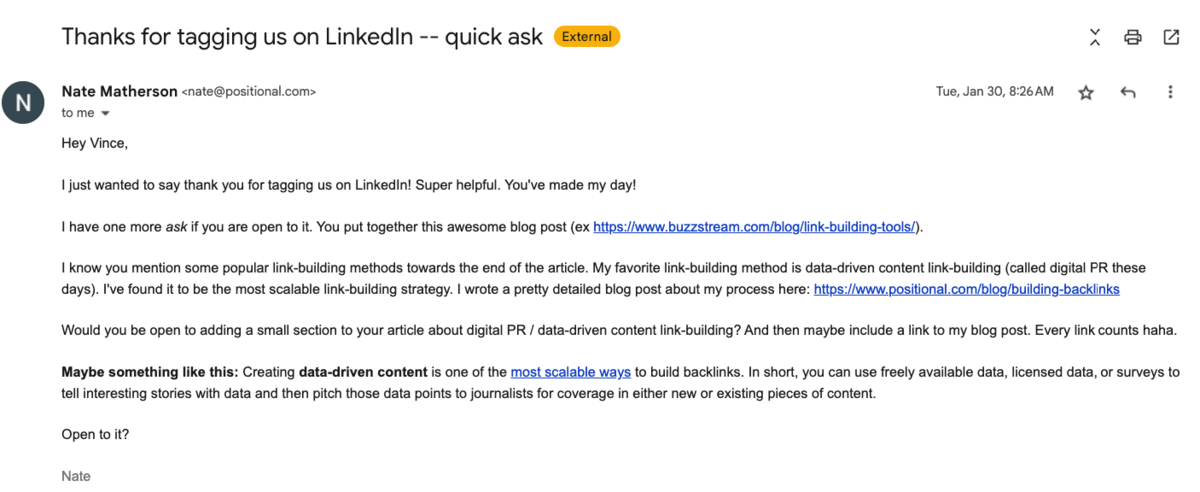
I saw the LinkedIn message first, so by the time I saw the email, it wasn’t a surprise.
I recommend experimenting with the different platforms because not everyone is active on everything.
Here are some common double-touches that I’ve used:
- Tweet first, DM next
- DM first, Email next
- LinkedIn message first, Email next
- LinkedIn comment first, LinkedIn message next
In all these cases, the idea is to get on the recipient’s radar so you aren’t a stranger.
5. Don’t Always Include an Ask
While this may feel counterintuitive, spending time building relationships with prospects rather than asking them for something immediately pays.
You can do this by introducing yourself to prospects and/or interacting with and sharing their social posts before you reach out.
Another example is this proactive, expert pitch:
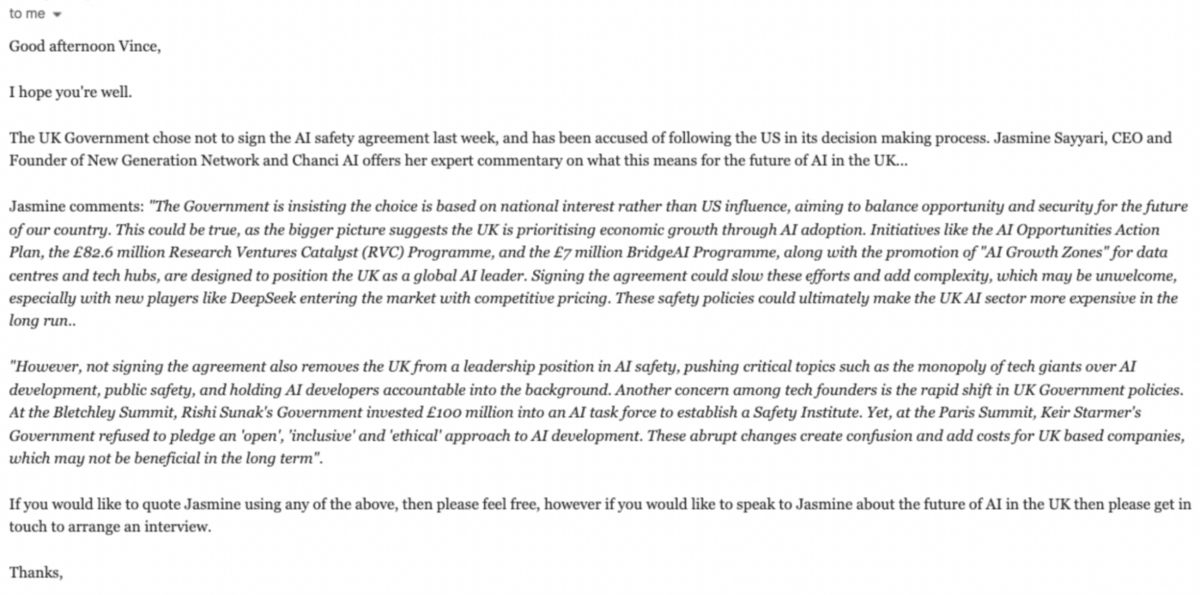
Although this isn’t necessarily relevant to me, it’s a solid, informative approach that doesn’t ask for anything and provides much value.
Another version of this is a pitch I received from an expert link builder:
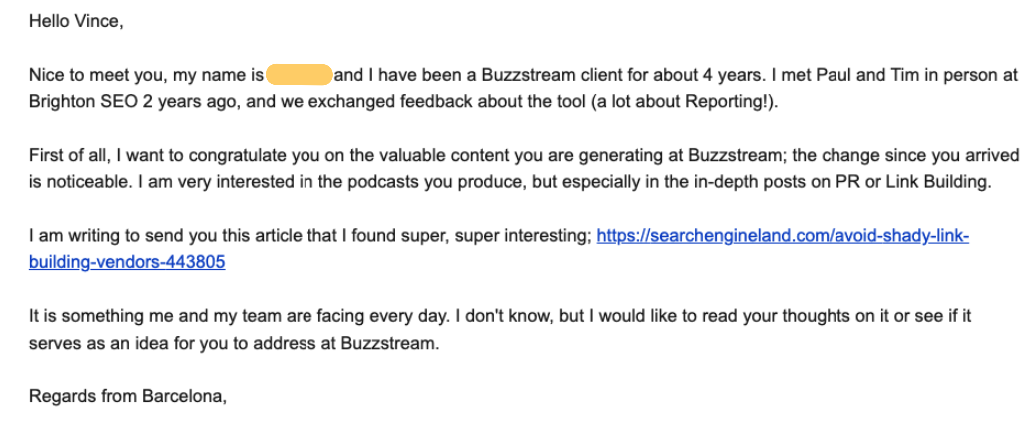
Instead of asking me to link to anything, they found a particular article they knew I might be interested in and just brought it to my attention.
Again, the email does not request linking or sharing the article; instead, it is just a subtle hint or wink.
These emails need to be hyper-focused. This tactic doesn’t work if I weren’t interested in this topic, so I know this link builder has done their research.
Building relationships with journalists is the best way to increase your likelihood of getting a response.
Most Emails Get No Replies
Overall, email outreach campaigns rarely get responses.
In this analysis, the overall reply rate for link builders is 3.59%, meaning almost 1 in 28 emails gets a reply. The digital PR dataset had a response rate of less than 1%.
I spoke to a few trusted digital PRs about this.
Why We Don’t Get Replies
I went to Collin Czarnecki again, who told me:
“As a former journalist, I can tell you firsthand that I rarely responded to pitches, unless I needed additional data or expert commentary to elevate my reporting.
There are typically three reasons why a journalist might not reply:
- You gave them everything they needed and no follow-up was necessary.
- They’re saving your pitch for later.
- They’re simply not interested in the angle, but are open to future pitches.
Additionally, if you have a pitch with an evergreen topic, you might get a response in the future if it resonates with the journalist. This could be later in the week, later in the month, or even months after you send the pitch.
Stay consistent, keep your outreach targeted, and remember that silence doesn’t always mean rejection.”
Digital PR expert Britt Klontz of Vada Communications told me:
Not receiving a reply from a journalist is entirely normal, even when your pitch ends up resulting in coverage.
If your pitch includes everything they need and has a clear story angle, there’s often no reason for them to reply. Journalists are busy people and typically work under tight deadlines, so I don’t take offense.
I look at it as a quiet win of good PR: you’ve done the legwork, so they don’t have to.
When the story does go live, my golden rule is always to send a thank-you note. A simple email shows appreciation and helps build authentic relationships.
The magic happens when you’re not just another pitch in their inbox, but someone they trust to deliver helpful, on-point insights when it matters most.”
Does that mean you should send more for a better reply rate? No.
As we saw previously, higher volume correlated with lower reply rates.
The real differentiating factor is better, targeted emails.
The days of large email blasts in link building and PR are over. Spend the time contacting the right person, and you will be rewarded.
Methodology
The parameters for this study are:
- The campaign must have over 25 emails sent to avoid one-off emails or errant campaigns.
- The campaign emails must have at least 50 words in the body, so we focus on initial pitches, rather than replies or follow-ups.
- No auto-replies or bounces are included in the overall analysis because they would skew the results drastically.

 End-to-end outreach workflow
End-to-end outreach workflow



 Check out the BuzzStream Podcast
Check out the BuzzStream Podcast


